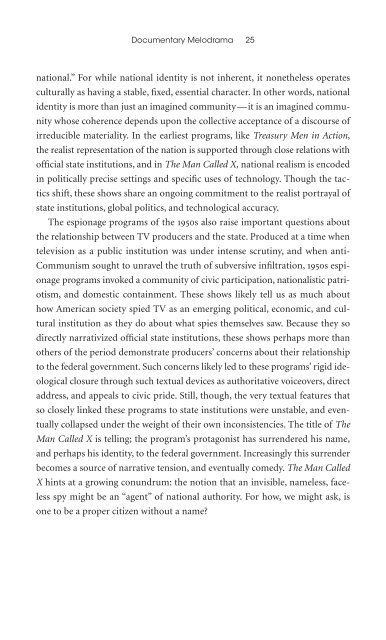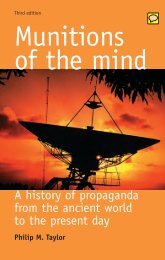Citizen-Spy
Citizen-Spy
Citizen-Spy
You also want an ePaper? Increase the reach of your titles
YUMPU automatically turns print PDFs into web optimized ePapers that Google loves.
Introduction xxxiii<br />
broadcast media scholarship. Anderson’s model has influenced the work of<br />
scholars like Michele Hilmes, who has discussed the ways in which radio and<br />
television have contributed to the formation of national cultures by casting<br />
the immigrant experience as central to a shared American heritage. 34 Similarly,<br />
Nina Liebman and Alan Nadel have shown how postwar American television<br />
bridged the gulf between the private and public spheres—in part by linking<br />
norms of gender and class to national political concerns—and George Lipsitz<br />
has shown how media representations of ethnicity helped ameliorate post–<br />
World War II tensions surrounding suburbanization and consumerism. 35<br />
At stake in these representations is citizenship—that authorized subject<br />
position that is the seemingly natural product of national history and beneficiary<br />
of state institutions and processes. Historically, this privileged position has<br />
been both gendered and racialized, with full agency reserved for white men,<br />
though the specific terms and boundaries of that privilege have continually<br />
shifted. In National Manhood: Capitalist <strong>Citizen</strong>ship and the Imagined Fraternity<br />
of White Men, Dana Nelson charts the influence of race and gender on<br />
ideals of citizenship during the late eighteenth and early nineteenth centuries,<br />
exploring “how and under what conditions ‘white’ manhood came to ‘stand’<br />
for nation, how it came to be idealized as a ‘representative’ identity in the United<br />
States.” Through an analysis of official political texts, medical journals, and<br />
nineteenth-century ethnographies, she discusses how white masculinity became<br />
established as an American national norm and ideal. “National/‘white’ manhood,”<br />
Nelson writes, “however effective for certain [cultural] purposes, is not<br />
a ‘unified’ identity. It is an impossible identity—impossible in the sense that it<br />
is an always-agonistic position, making it difficult for any human to fit into a<br />
full sense of compatibility with its ideal construction.” National manhood not<br />
only works to exclude women and people of color from full citizenship and<br />
agency; it also is an impossible ideal for white men themselves. 36<br />
It is overly simplistic, then, just to identify the normative impulses within a<br />
particular set of representations or discourses. While dominant norms of citizenship<br />
do largely mirror the race, gender, and class hierarchies that suffuse<br />
American society, the ways in which those norms are articulated—and the<br />
externalized threats against which they are measured—vary considerably. In<br />
Being Political: Genealogies of <strong>Citizen</strong>ship, Engin Isin argues that citizenship,<br />
while constituted in discourses of exclusion—of those various strangers and



